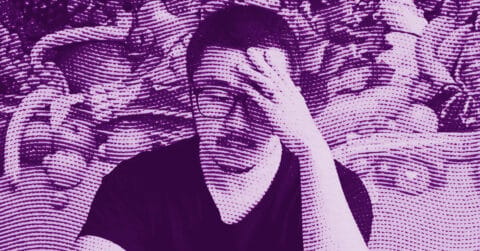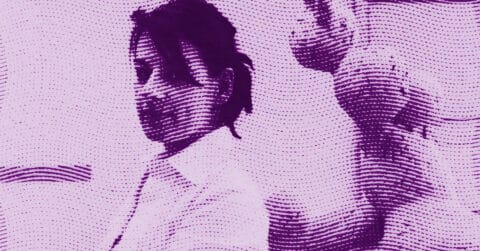Listen to me carefully, you bunch of snobs, the art of Rosemarie Trockel (born in 1952 in Schwerte) is a real punch in the stomach to artistic conformity. This German artist, whose multifaceted work defies any simplistic categorization, forces us to rethink our certainties with a boldness that shakes the walls of institutions.
Let us begin with her masterful deconstruction of domestic symbols, notably through her monumental stovetops that transform daily oppression into a visual manifesto. Those obsessive black circles, those accusatory eyes staring at us from museum walls, are not just simple Duchampian ready-mades. No, they represent an alchemical transmutation of the banal into the sublime, a sarcastic elevation of household appliances to the rank of contemporary icons. As Linda Nochlin might have suggested, these works constitute a subversive appropriation of domestic oppression tools, transforming them into weapons of massive deconstruction of gendered prejudices.
But beware, do not fall into the trap of a solely feminist reading. These hotplates are also an ironic slap to male geometric abstraction, a provocative thumb in the eye to Malevich and his disciples. In “Untitled” (1994), the methodical arrangement of black circles on a white background creates a palpable tension between the banality of daily life and the pretension of minimal art. This is precisely what John Berger called “the dialectic of the visible and the invisible,” here, the invisible being the weight of social conventions hidden behind the smooth surface of appliances.
Trockel’s stovetops are not simply arranged at random; they follow a precise choreography, a macabre dance mocking the modernist obsession with the grid. Each black circle becomes a black hole that sucks in our certainties about art, gender, and the hierarchy of mediums. It is a fierce intellectual game that recalls what Rosalind Krauss wrote about the grid as a prison of modern art, but Trockel transforms this prison into a subversive playground.
The second characteristic of her work lies in her famous “knitted paintings,” those monumental works produced industrially that shatter the boundaries between craft and fine art. Make no mistake: these knits are not a nostalgic homage to our grandmothers’ needlework. They are textile manifestos of rare conceptual violence. By using machines to produce these works, Trockel performs a double reversal: she elevates “women’s work” to the rank of art while mechanizing it, thus stripping it of its traditional sentimental dimension.
These monumental knits, with their repetitive patterns of hijacked logos, the Playboy bunny, the swastika, the hammer and sickle, are conceptual time bombs. They operate like computer viruses in the art system, corrupting established codes and creating new synaptic connections between high art and low culture. As Arthur Danto brilliantly analyzed, these works enact a transfiguration of the banal, but with an explosive political dimension that Warhol would never have dared to explore.
The mechanical repetition of motifs in her knits is reminiscent of propaganda techniques, but Trockel subverts them by emptying them of their original meaning. The Playboy bunny, the quintessential symbol of female objectification, becomes an abstract hieroglyph, a floating signifier that loses its original power to become a tool of social critique. This is what Geoffroy de Lagasnerie might call a “deterritorialization” of power: patriarchal symbols are hijacked and turned against themselves.
The most fascinating aspect of these knits is that they function simultaneously as abstract painting and as social commentary. The repeated patterns create hypnotic visual structures that rival any modernist composition, while carrying a sharp political message. It is a conceptual tour de force that makes minimal art look like a superficial stylistic exercise.
The use of the industrial knitting machine is not a mere technical choice; it is a declaration of war against male gestural expressionism. By replacing the heroic gesture of the painter with the mechanical precision of the machine, Trockel demystifies the creative act while producing works of chilling beauty. These smooth, impersonal surfaces are like mirrors that reflect back to the viewer their own prejudices about art and gender.
Trockel’s strength is that she maintains constant ambiguity. Her works never reduce themselves to a simple feminist critique or a pure formal exploration. They oscillate perpetually between different levels of reading, creating an intellectual vertigo that forces the viewer to question their most deeply rooted certainties.
Her systematic refusal to be locked into a category is itself a political act. When the art world tried to reduce her to “the artist who knits,” she began producing videos, sculptures, installations. When she was seen only as a feminist, she created works that escape any gendered reading. This strategy of permanent evasion is her most authentic signature.
Trockel’s more recent installations continue this logic of perpetual destabilization. In “Replace Me” (2011), a modernist sofa covered in plastic becomes a troubling meditation on bourgeois comfort and its unsaid aspects. The plasticized surface, with its black brush marks, evokes as much a crime scene as an abstract painting. It is an object that refuses to choose between sculpture and painting, between social critique and formal exploration.
Her work with ceramics in recent years perhaps represents her boldest provocation. By creating forms that seem inspired both by meteorites and internal organs, she continues to blur the boundaries between nature and culture, between organic and artificial. These pieces, with their sensual glazed surfaces and unsettling shapes, perfectly embody the ambivalence that characterizes her entire oeuvre.
Trockel’s practice is a great lesson on how art can maintain its subversive power in the era of late capitalism. By constantly refusing to give the market what it expects, avoiding the traps of stylistic signature, she creates a space of resistance within the very system she critiques.
Throughout her work, Rosemarie Trockel maintains a unique position: that of a lucid observer who rejects both easy cynicism and naive engagement. Her works are thought machines that continue to function long after they have left our sight. They keep working in our minds, eroding our certainties, opening new perspectives.
Trockel’s genius lies in her creation of works that simultaneously function as seductive aesthetic objects and conceptual time bombs. She reminds us that the most powerful art is that which refuses easy solutions and keeps alive the contradictions that define us.
















